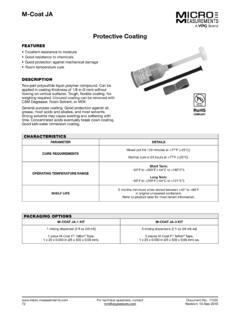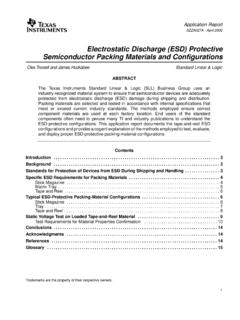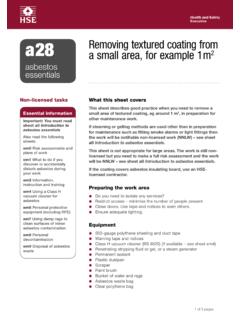Transcription of GUIDE TO LENSES - Davis Vision
1 GUIDE TO LENSESP lease note: Lens type and brand are prescribed according to provider LENS OPTIONS:Anti-Reflective coating (Non-glare): Anti-Reflective (AR) coating reflects light off the lens surface, providing wearers with a reduction in glare and eye fatigue. Anti-Reflective coating is especially helpful when driving after dark and working on a computer. Anti-Reflective coating is typically sold under a variety of brand names. Anti-Reflective categories include: Standard AR Standard AR offers reduced internal and external reflections, creating a better cosmetic appearance. Premium AR Premium AR offers reduced internal and external reflections plus they are easy-to-clean, safer and more impact resistant than standard AR LENSES . Ultra AR Ultra AR offers the best in anti-reflective benefits including exceptional visual clarity and the virtual elimination of reflections and glare. They are easy to clean, repel water, dirt and fingerprints better, provide improved scratch resistance, and enhanced UV or plastic LENSES : Plastic has replaced glass as the material used in eyewear due to its high impact resistance and cost efficiency.
2 We still do administer and offer glass LENSES if medically necessary. Single- Vision LENSES : Used to correct for only one distance; same prescription throughout entire lens. Lined bifocal LENSES : The upper part of the lens is used for distance Vision and the lower part of the lens is used for near Vision . The difference between watching TV and reading for example. Trifocal LENSES : Used for three different distances, upper is for distances, like driving for example, middle is for intermediate distances, like looking at a computer, and the lower segment is for reading. Lenticular LENSES : Used to correct extreme hyperopia (farsightedness) which causes difficulty focusing on near objects. This condition often created by cataract surgery when lens implants are not possible. They are also referred to as post-cataract or post-operative LENSES : Are an alternative choice to plastic LENSES . High-Index LENSES are comprised of a dense material, resulting in thinner and lighter LENSES than those produced from plastic.
3 High-Index LENSES are especially useful to those with strong prescriptions, creating eyeglasses that are comfortable to wear without the awkward look of thick Photochromic LENSES : Plastic Photochromic LENSES are light-adaptive and darken when they are exposed to ultraviolet rays. The most common brand is called Transitions adaptive LENSES or generic versions called, photochromic or photosensitive LENSES , these LENSES provide the wearer protection from the harmful effects of the LENSES : Polarized LENSES are used in sunglasses and provide wearers with a filter to eliminate the horizontal glare experienced from reflective surfaces, such as water or the road s surface. Polarized LENSES are also capable of being worn indoors to protect light-sensitive individuals from light exposure. These LENSES are recommended for patients with eye conditions such as cataracts and age related macular LENSES : Polycarbonate LENSES are comprised of a lightweight impact-resistant material and are used where eye safety is a concern.
4 Additionally, Polycarbonate LENSES provide protection from the sun s UV rays. Popular uses include safety eyewear, sports protective eyewear and children s eyeglasses. Children: Polycarbonate LENSES are covered in full (no copayment) for dependent children. Adults: Polycarbonate LENSES are covered for adults if they are monocular patients and patients with prescriptions +/- diopters or greater. Monocular patients see out of one eye. A diopter is a unit of measurement of the optical power of the lens. Convex LENSES have positive value (+ to + for example) and are used to correct farsightedness. Concave LENSES have negative value ( to for example) and are used to correct nearsightedness. Optometrists usually measure refractive error using LENSES graded in steps of LENSES : Progressive LENSES provide continuous progression of lens powers between multifocal LENSES , resulting in many lens powers to facilitate all viewing distances without the visible line of bifocal or trifocal LENSES .
5 They are categorized in the following groups within the Davis Vision formulary which includes many popular brand names and the latest technology: Standard: Standard progressive LENSES will give you a fairly wide reading area. They require a certain sized frame to allow enough vertical height to give a smooth transition from distance Vision down to reading. Premium Progressives: Gone are the days of having to sacrifice fashion for progressive LENSES . Slightly more expensive than standard progressive LENSES , premium (short corridor) progressive LENSES are designed to fit into smaller frames. Premium progressive designs also provide an even wider field of view in the distance and reading viewing areas vs. standard progressive designs. Select Progressives (Availability varies by plan): Select progressives are designed to meet the visual needs of those who lead active lifestyles. They provide wider and clearer fields of Vision when looking ahead and into the distance.
6 Ultra/Digital Progressives (Availability varies by plan): Ultra/Digital progressives offer exceptional comfort with highly accurate LENSES ; custom designed to the wearer s prescription. They can provide enhanced visual clarity when combined with high definition materials (such as High- Index) and premium anti-reflective coatings. See Tech Watch for additional WatchCommonly referred to as free-from or HD progressive LENSES , this new optimized lens design offers the latest in progressive lens technology and is ideal for people with specific visual needs. This includes those who are new to progressives and needing them for the first time. Also suitable for those motivated to wear progressive LENSES , but have had issues adapting to them in the past, as well as current progressive wearers interested in the latest free-form LENSES the fabrication of the LENSES from the wearer s eyeglass prescription is optimized with computer-controlled surfacing equipment that is much more precise than conventional tools.
7 The result is that high-definition digital progressive LENSES may provide sharper image quality, better peripheral Vision and improved contrast sensitivity. This digitally enhanced technology is available in multiple lens materials and brand names. When combined with a premium anti-reflective coating these LENSES offer the best visual experience for the progressive lens wearer. These LENSES are featured as options within the Premium and Ultra Progressives Lens categories within the Davis Vision Protection Plan: A warranty which ensures that if the coating does not prevent scratches it will be replaced at no additional Resistant coating : Many LENSES manufactured today automatically come with a basic scratch resistant coating . Although scratch resistance does not mean 100% scratch proof, it can help to prevent minor scratches that can occur with daily wear. This is different from the Scratch Protection Plan offered by Davis of Plastic LENSES : Tinting can be added for fashion, functionality, or both.
8 Tinting is done on regular LENSES ; however, tinting cannot be done on non-glare LENSES . Tinting can be done in various colors and at different levels from mild to dark. For example, yellow tinted LENSES can benefit people who do a lot of driving. The yellow tinting can add contrast and can decrease fatigue and increase visual acuity when driving in fog, haze, or during overcast coating : Ultraviolet coating provides sun protection for the wearer s eyes, blocking harmful ultraviolet light. Too much exposure to the sun can result in eye damage including cataracts and retinal damage. UV coating is different from the tinting applied to LENSES - dark tinted LENSES that do not filter UV lighting may actually put the eyes at greater risk. Pupils may remain larger due to the dark tinting, allowing more unfiltered UV light to (Video Display Terminal): A term that refers to a specific type of glasses designed to be worn while working on the computer to address the different visual requirements and distance of the wearer.
9 May also be referred to as occupational glasses and addresses a condition commonly referred to as computer Vision syndrome . Usually VDT glasses are only covered as a second pair if they are ordered at the same time as the primary or main LENS OPTIONS, TYPES & TERMS:Contact Lens Evaluation, Fitting & Follow-Up Care (CLEFFU): If you wear or want contacts, you need a contact lens exam in addition to a comprehensive eye exam. Your eye doctor will perform special tests during a contact lens exam to evaluate your Vision with contacts. The first test will measure your eye surface to determine what size and type of contacts are best for you. Your doctor may also do a tear film evaluation to make sure you have enough tears to comfortably wear the results of those tests, your eye doctor can provide a contact lens prescription that is the right fit for your eyes. An eyeglass prescription is no substitute for a contact lens exam because the two are very different.
10 An eyeglass prescription measures for LENSES that are positioned approximately 12 millimeters from your eyes; whereas a contact lens prescription measures for LENSES that sit directly on the surface the eye. An improper fitting or prescription of contacts can damage the health of the you have the correct fit and prescription for contacts, you ll need to decide whether you want disposable contacts or extended wear, and if you want your contacts to be doctor will fit you with a trial pair of contacts and have you wear them for a few days. In about a week, you ll need a follow-up exam to make sure you have adjusted to your new you wear glasses or contacts, it s a good idea to get a yearly eye exam to see if you have new or existing Vision problems, and if you need Vision s the Difference Between an Eye Exam and a Contact Lens Exam?A routine / comprehensive eye exam is not the same as a contact lens exam. For contact lens wearers, a contact lens exam is necessary to ensure the LENSES are fitting both eyes properly and that the health of the eyes is not harmed by the contact comprehensive eye exam is an important part of caring for your overall health whether you need Vision correction or not.



